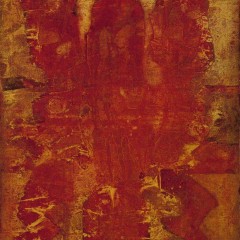—Maeve’s review delves into the hybrid animal-human figures that suggest a metaphorical connection between the animal kingdoms and what that means.–the Artblog editors————————->
In Undomesticated, the first retrospective for Delaware-based artist Hunter Clarke, the visitor is immediately assailed by a multitude of chimera-like creatures boasting the heads of animals mounted on female human bodies. The most striking element of these beings is not their hybridity, however, but the fact that each of them sports a resplendent pregnant belly.
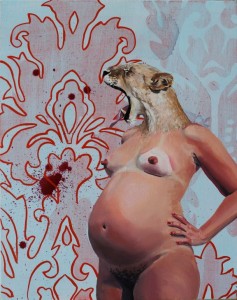
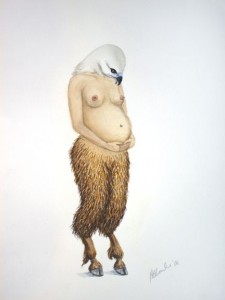
Clarke’s Source Material and Influences on Display
Clarke points to 19th century botanist drawings by Martin Johnson Heade as one influence for her earlier, more romantic portraits, inviting comparisons to anthropological studies.
The artist also asserts that her fascination with these unique hybrids stems from a combination of factors, including her interest in naturalistic illustrations of mammals and birds, her pursuit of portraiture as a means of creating distinct ‘characters,’ and her fascination with the strangeness of pregnancy.
For her human subjects, Clarke prefers to paint from images rather than life to avoid asking her pregnant models to pose for long periods of time. She has also been known to covertly spirit away nature magazines from her doctor’s office upon finding particularly eye-catching photographs of wild animals.
In a nook at the very back, the artist has arranged her output from a residency at the Winterthur Museum, Garden and Library, including “No, Yes, No” a large 80 x 72 inch oil painting of two regal chimeras. The setting of this piece is a peculiar amalgamation of Mrs. DuPont’s bedroom, replete with family portraits, an ornate fireplace and historical lighting fixtures, and the artist’s own studio, including an air conditioning unit and a self-portrait at her easel. The title alludes to the frustration felt by Clarke when her wish to take reference photographs of nude models at the estate was rebuffed. She was therefore compelled to create an awkward juxtaposition of photographs from Winterthur, paired with live female models in her studio. The result is a somewhat blurred background recalled largely from memory, juxtaposed against a sharper, more present foreground.
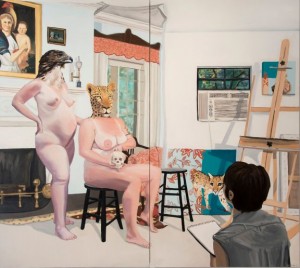
Buddhism and Motherhood
Both covering the right wall and immediately greeting visitors at the front entrance is Clarke’s “Maitreya” (or Buddha-to-be-born) series, her first venture into loose-leaf works on paper, created specifically for this exhibition.
The artist conceptualizes these works as a way to explore the vast array of psychological states that motherhood fosters in her, thereby releasing any negative emotions and replacing them with renewed positivity. Here, Clarke’s Buddhist beliefs come into play, as she investigates themes of interconnectivity and existence.
This focus is made clear in the title of “No Coming, No Going,” which originates from a bedtime melody:
No coming, no going
No after, no before
I hold you close to me,
I release you to be so free,
Because I am in you and you are in me
Clarke often contemplates when her children originally ‘existed’ for the first time, what they were before conception, and when their individual actualities separated from her own. She also posits that living does not, in fact, have any clear endpoint, nor do human beings subsist as wholly separate entities from one another.
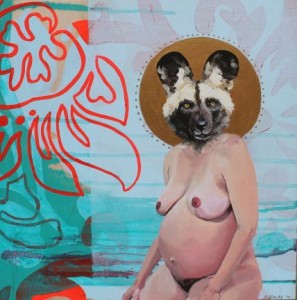
In addition to the mysterious links between mothers and children, another prevalent theme that informs all of Clarke’s work is our instinctual nature as humans who are much more animal-like than we would like to believe. The artist uses the example of the realities of motherhood to remind us that we are essentially primal beings, guided by urges and can oftentimes be “oozy, messy and gross.”
Asked if she will continue to explore these same animal-woman crossbreeds in her art, Clarke stated that she views this subject as endlessly fascinating; it has never become stagnant for her. Occasionally she will revisit her early illustrations of animals, but ultimately Clarke always returns to this long-held passion. For some, the artist asserts, her work incites fear or distaste, while for others, it is beautiful and humorous. Her only goal is to foster shock, empathy and at times visceral reactions, while also scrutinizing her own role as a mother in the context of a transcendent, interrelated world.
Undomesticated, to May 24, 2013. Dylan Gallery, The Piazza @ Schmidt’s, 1050 N. Hancock St (Suite 84), Philadelphia. All images courtesy of Hunter Clarke. Opening reception May 3rd, 6-9pm with a performance by Beck-Fields.


